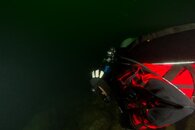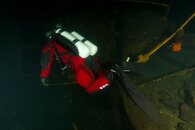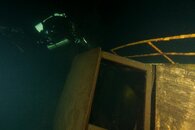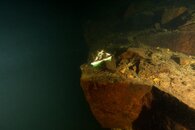Maybe i m doing something wrong and i'd be very grateful if somebody points me to the right path. But i hv found autofocus on DSLR (in my case 7D with EF-S 10-22mm) to be real menace. Once it becomes dark (depth or night or low vis), when i press the shutter, typically this happens: camera starts focusing, strobe fires a pre-flash, but that is - my guess - too short for camera to get focused, so the camera fires another pre-flash .. and that goes ad nauseam. All creatures from fish to buddies get p...d off and dont want to participate in the photographing activity anymore. You can forget about composition, coz the shot just comes out randomly, if at all. Also, time runs really fast in depth... etc.
It is even more annoying coz when Her Autofocusy finally decides to bless me with a shot, usually it is sharp and clean, just what u would expect, see below. (Pics not perfect, left strobe being still too much into the picture but due to this issue i was actually happy just when camera fired AT ALL.)
With macro, i tried to use the assisting beam in my strobes (i use red cover lid on my Inon Z240 so it is red) but it did not work very well. The most important reason is that usually u hv the strobes slightly off the subject in order to eliminate backscatter, so the assisting red light on strobe usually points somewhere else than subject. Which is even more the case of wide angle - the strobes point in completely different direction.
I also tried to use my UW light, but that created another sort of problems: first, it is quite strong, so it was visible in some shots, second, it created backscatter.
Maybe i m using wrong autofocus mode? One more thing, i hv the diffuser on the strobes all time, and i got a red cap on the assisting light (the weak light that can be on all time) - i must admit i hv never tried to use the assisting light in white color, but as i said, since usually it points other direction than subject, i m not sure if it would work better than red light... ?
It is extremely frustrating and really ruins my day down there, that's why I would really appreciate any help with this issue.




It is even more annoying coz when Her Autofocusy finally decides to bless me with a shot, usually it is sharp and clean, just what u would expect, see below. (Pics not perfect, left strobe being still too much into the picture but due to this issue i was actually happy just when camera fired AT ALL.)
With macro, i tried to use the assisting beam in my strobes (i use red cover lid on my Inon Z240 so it is red) but it did not work very well. The most important reason is that usually u hv the strobes slightly off the subject in order to eliminate backscatter, so the assisting red light on strobe usually points somewhere else than subject. Which is even more the case of wide angle - the strobes point in completely different direction.
I also tried to use my UW light, but that created another sort of problems: first, it is quite strong, so it was visible in some shots, second, it created backscatter.
Maybe i m using wrong autofocus mode? One more thing, i hv the diffuser on the strobes all time, and i got a red cap on the assisting light (the weak light that can be on all time) - i must admit i hv never tried to use the assisting light in white color, but as i said, since usually it points other direction than subject, i m not sure if it would work better than red light... ?
It is extremely frustrating and really ruins my day down there, that's why I would really appreciate any help with this issue.








